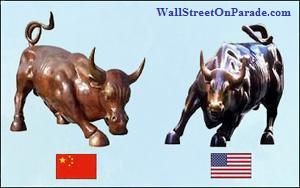By Pam Martens: July 7, 2015
If you happened to be sitting behind a Wall Street trading terminal on Tuesday, October 20, 1987, you are likely having heart palpitations reading about what’s currently happening in the Chinese stock market. Tuesday, October 20, 1987 was the day after Black Monday, the infamous U.S. stock market crash that shaved 22 percent off the Dow Jones Industrial Average in a single day.
Only those working behind a trading terminal the day after the crash can truly appreciate the horror of having customer orders to sell their stock and having no idea as to the price at which the stock was trading despite the market being technically open for trading. On Tuesday, October 20, 1987, the U.S. stock market was less of a market and more of a crapshoot. So many stocks had been halted for trading that futures markets in Chicago had to stop trading since so many of the component stocks in the futures indexes were simply not trading in New York, thus their actual prices were unknown.
The official report on that episode, known as the Report of the Presidential Task Force on Market Mechanisms (or Brady Commission Report), referred to that Tuesday market as “dysfunctional,” writing:
“Although Monday was the day of the dramatic stock market decline, it was midday Tuesday that the securities markets and the financial system approached breakdown. First, the ability of securities markets to price equities was in question. The futures and stock markets were disconnected. There were few buyers in either market and individual stocks ceased to trade. Investors began to question the value of equity assets.”
How did the market get out of that dangerous gridlock? Major publicly-traded corporations, no doubt at the behest of an invisible hand, began to announce huge stock buybacks – a total of $6 billion in all. That calmed the market and the Dow closed up on the day.
There are few things more panic-inducing to investors and stock brokers than news of extended trading halts in the middle of a market meltdown. It suggests an act of desperation and it triggers an immediate urge to sell everything else before those stocks are also halted from trading.
Against that backdrop, Bloomberg is reporting this morning that 26 percent of stocks trading on mainland China stock exchanges have been suspended from trading. A trading “halt” suggests a temporary measure; a trading “suspension” suggests a much longer-term time frame. Bloomberg goes on to report that the “suspensions have locked up $1.4 trillion of shares.”
The immediate question that comes to mind is that to qualify as a stock market, there has to be a two-sided market. If an investor can’t exit 26 percent of the stocks that are listed on the exchanges, if an investor and the marketplace have no idea where a quarter of the market is priced, is this really still a stock market? The Brady Commission’s use of the word “dysfunctional” to describe one day of trading in 1987 hardly captures the degree of market ruptures in China.
Adding to the mood of desperation on the part of Chinese authorities, the Financial Times is reporting that journalists in China have been told that they are no longer allowed to report on suicides by “equity citizens,” the catchphrase used in China to describe retail stock investors.
Retail investors now make up 80 to 90 percent of the Chinese stock market, according to the Financial Times. They are heavily margined, just as the unsophisticated retail investors were in the U.S. market crash of 1929. And in a further similarity to 1929, where the guys shining shoes were giving out hot stock tips to their customers, the Wall Street Journal reported yesterday that a Chinese woman had invested on a tip from her hairdresser. Yesterday evening, CNBC described an Uber taxi driver in China who was trading from his car.
During 1929, brokerage firms, in hopes of drumming up more retail customer business, lined up chairs in their offices so that customers could drink coffee, eat donuts, watch the ticker tape and make trades. Photos are now coming out of China showing brokerage firms with dozens of stock market computers lined up in their offices for the retail investor.
The Chinese government is openly tinkering in the stock market. To shrink supply, it has stopped Initial Public Offerings (IPOs) coming to market. It is also providing a direct line of support from its central bank to its state-backed margin finance company. At the end of June, following a plunge in the market, the People’s Bank of China (the country’s central bank) announced it would cut its one-year lending rate by a quarter point, the fourth cut since last November.
Despite all the government tinkering, the Shanghai Composite index is down over 30 percent from its peak this year with wild intraday swings adding to investor nervousness. Today, the index was down as much as 5 percent before closing with a loss of 1.3 percent. The Shenzhen Composite of much smaller companies and tech stocks, lost 5.3 percent on the day.
The suspension of issuing new IPOs in China could cause serious business and economic dislocations. Many of the companies with planned IPOs are heavily indebted and need the IPO infusion of cash to keep going or expand. China is also a major importer of crude oil and other industrial commodities. Its stock market troubles are being interpreted by commodity markets as another reason for shrinking commodity demand in an already oversupplied marketplace. Yesterday, domestic U.S. crude oil (West Texas Intermediate) dropped by almost 8 percent and is down another 2.44 percent in Nymex trading this morning at 10:38 a.m.
The troubles in the Eurozone with Greece teetering and serious dislocations in China are impacting export markets for U.S. goods. The U.S. Commerce Department reported this morning that the U.S. trade deficit widened in May to $41.9 billion from April’s revised $40.7 billion while exports declined 0.8 percent.


